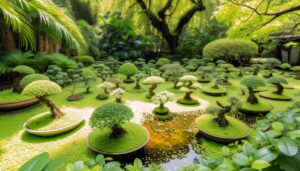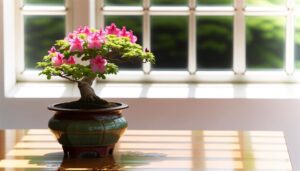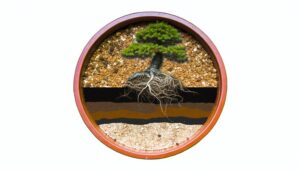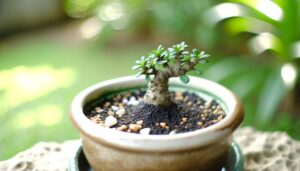Do Bonsai Seeds Need Light to Germinate?
Light's role in bonsai seed germination is species-specific. Photomorphogenesis, influenced by light quality, intensity, and photoperiod, critically affects seedling development.
For instance, tropical species like Ficus require high light intensity for best growth, while temperate species such as Acer palmatum may thrive with moderate light levels. Using grow lights can help control light conditions, ensuring 12-16 hours of exposure to facilitate chlorophyll synthesis and robust seedling growth.
Mismanagement of light exposure can hinder germination rates and seed viability. With appropriate light conditions, you can notably enhance germination success and seedling vigor.
Explore further to refine your bonsai growth strategy.

Key Takeaways
- Bonsai seeds' light requirements vary by species, with some needing light for germination while others do not.
- Tropical bonsai species generally need high light intensity for successful germination.
- Red and blue light spectrums are crucial for regulating bonsai seedling growth and development.
- Indoor germination allows for precise control of light exposure, beneficial for species with specific light needs.
- Ensuring 12-16 hours of light per day can improve germination rates for light-dependent bonsai seeds.
Understanding Seed Germination
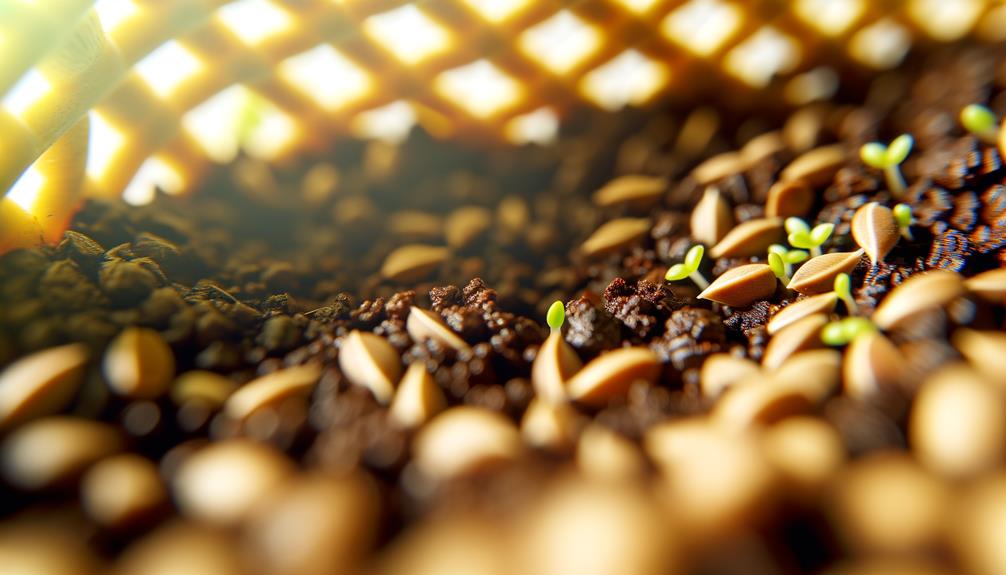
Seed germination, a crucial phase in the lifecycle of bonsai plants, entails the initiation of growth from a dormant seed under best conditions.
This process begins with imbibition, where the seed absorbs water, activating metabolic pathways essential for growth. The seed coat softens, and enzymatic activities break down stored food reserves, providing energy for the embryonic plant.
Best temperature, moisture, and oxygen levels are pivotal for successful germination. The radicle, or embryonic root, emerges first, anchoring the plant and allowing nutrient uptake.
Following this, the plumule, or young shoot, grows upward, signifying the seedling's change towards photosynthesis. Understanding these physiological mechanisms is optimal for cultivating healthy bonsai, ensuring robust development from seed to mature plant.
Light's Role in Germination
Following the initiation of germination processes, light becomes a key environmental factor influencing the subsequent development and vigor of bonsai seedlings. Photomorphogenesis, the growth and development of plants in response to light, plays a pivotal role in determining the morphology of bonsai.
Light quality, intensity, and photoperiod can have a significant impact on chlorophyll synthesis and photosynthetic efficiency. Red and blue light spectrums are vital for best growth, as they regulate phytochrome and cryptochrome photoreceptors, respectively.
Adequate light exposure ensures strong root and shoot development, reducing etiolation and promoting healthy, compact growth. As such, understanding the specific light requirements for bonsai species is essential for fostering successful seedling establishment and subsequent cultivation.
Common Bonsai Species
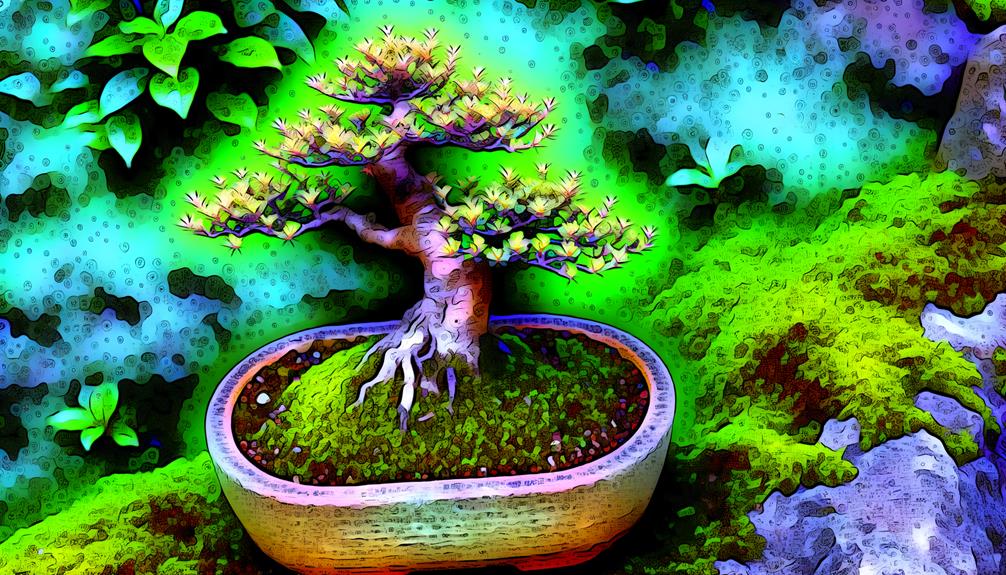
When considering bonsai cultivation, several species are particularly popular due to their aesthetic appeal and adaptability. These include Juniperus, Ficus, and Acer palmatum. Each species exhibits unique growth requirements that influence their light, water, and soil needs during the germination phase.
Understanding species-specific care is essential for optimizing germination success and ensuring robust development.
Popular Bonsai Trees
Among the most commonly cultivated bonsai species are the Japanese Maple (Acer palmatum), Chinese Elm (Ulmus parvifolia), and Juniper (Juniperus spp.), each chosen for their distinct aesthetic and adaptability to bonsai cultivation techniques.
Acer palmatum is favored for its vibrant seasonal foliage and intricate branching, making it ideal for detailed pruning and shaping.
Ulmus parvifolia, known for its fine, serrated leaves and rugged bark, offers resilience and ease of maintenance.
Juniperus species are highly adaptable, with needle-like foliage and flexible branches that respond well to wiring and shaping. These species thrive under bonsai cultivation due to their manageable growth patterns, allowing enthusiasts to create diverse and intricate miniature landscapes.
Growth Requirements
Understanding the specific growth requirements of popular bonsai species such as the Japanese Maple, Chinese Elm, and Juniper is essential to ensuring their successful cultivation and maintenance. These species exhibit distinct preferences for soil composition, watering routines, and temperature ranges.
The Japanese Maple (Acer palmatum) thrives in well-draining, slightly acidic soils and requires partial shade. The Chinese Elm (Ulmus parvifolia) benefits from moderate watering and tolerates a wide range of soil pH levels. Junipers (Juniperus spp.), being drought-tolerant, prefer sandy, well-draining soils and full sunlight.
Ensuring ideal humidity and consistent pruning also plays a vital role in promoting healthy growth. Understanding these fundamental growth parameters can greatly enhance the vibrancy and longevity of these esteemed bonsai species.
Species-Specific Care
Each common bonsai species, such as the Ficus, Azalea, and Pine, necessitates tailored care regimens to optimize their health and aesthetic appeal. These species exhibit distinct physiological and environmental requirements. For instance, Ficus bonsai thrive in indirect light and require consistent moisture, while Azalea bonsai prefer acidic soil and partial shade. Pine bonsai, on the other hand, demand full sunlight and well-draining soil to prevent root rot.
Key care considerations include:
- Watering: Adjust frequency based on species-specific needs and environmental conditions.
- Soil Composition: Utilize suitable soil mixtures to guarantee proper drainage and nutrient availability.
- Pruning Techniques: Implement species-appropriate pruning methods to maintain desired shape and promote health.
- Light Exposure: Monitor and adjust light conditions to meet the specific requirements of each bonsai species.
Light Requirements by Species
Understanding the light requirements for bonsai seed germination necessitates a distinction between tropical and temperate species.
Tropical bonsai seeds, such as Ficus and Serissa, typically require higher light intensity and longer photoperiods to initiate germination.
Conversely, temperate species like Maple and Pine often germinate under moderate light conditions, benefiting from shorter photoperiods reflective of their native habitats.
Tropical Species Light Needs
Tropical bonsai species generally require high light strength to thrive, often necessitating additional artificial lighting when grown indoors. These species, adapted to equatorial regions, demand consistent, bright light conditions for best photosynthesis and growth. Inadequate light can lead to etiolation, characterized by elongated stems and pale foliage, compromising the plant's health and aesthetic appeal.
Cultivators should consider:
- Light Strength: Aim for a minimum of 2000 lumens per square meter.
- Light Duration: Provide 12-14 hours of light daily to mimic natural conditions.
- Light Quality: Use full-spectrum LED lights to guarantee balanced red and blue wavelengths.
- Proximity to Light Source: Maintain a 12-18 inch distance from artificial lights to avoid heat stress.
Following these guidelines ensures vigorous growth and vibrant foliage in tropical bonsai species.
Temperate Species Light Needs
Temperate bonsai species generally require moderate light conditions, with specific needs varying significantly among different species. For instance, Acer palmatum (Japanese Maple) seeds benefit from indirect light during germination, as excessive direct sunlight can hinder their development.
Conversely, Pinus sylvestris (Scots Pine) seeds exhibit ideal germination under full sun exposure, leveraging photoperiodic cues. Fagus sylvatica (European Beech) seeds require a stratification period followed by exposure to moderate light to break dormancy.
It is crucial to tailor light conditions to the specific temperate species to ensure successful germination. Understanding the photobiological needs of each species allows for the creation of an excellent microenvironment conducive to seedling vigor and health.
Indoor Vs Outdoor Germination
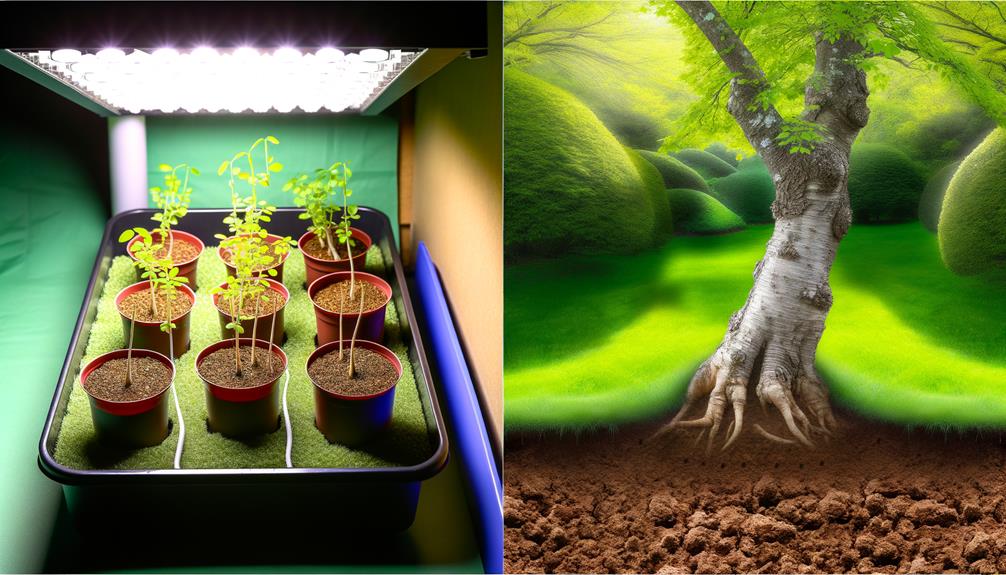
When deciding between indoor and outdoor germination for bonsai seeds, it is important to take into account factors such as temperature control, light exposure, and humidity levels, which can greatly influence seed viability and growth. Indoor germination allows for precise environmental regulation, ideal for species with specific germination requirements. In contrast, outdoor germination benefits from natural light cycles and ambient temperatures but can be unpredictable.
Key considerations include:
- Temperature Stability: Indoor environments can maintain consistent temperatures, ideal for germination.
- Light Quality: Outdoor germination provides full-spectrum sunlight, beneficial for photosynthesis.
- Humidity Control: Indoor settings allow for tailored humidity, reducing the risk of desiccation.
- Pest Management: Indoor germination minimizes exposure to pests and pathogens prevalent outdoors.
Choosing the best environment requires balancing these factors for successful germination.
Artificial Light Options
Effective germination of bonsai seeds indoors often requires the use of artificial light sources, such as fluorescent, LED, or high-intensity discharge (HID) lamps, to simulate ideal sunlight conditions.
Fluorescent lights are cost-effective and produce a broad spectrum that supports photosynthesis.
LED lights, known for their energy efficiency and longevity, can be customized to emit specific wavelengths conducive to seedling growth.
HID lamps, including metal halide (MH) and high-pressure sodium (HPS) varieties, provide intense light output, beneficial for species requiring higher light levels.
Each type of artificial light has its unique spectral qualities and intensity, making it essential to select the appropriate source to match the specific photobiological needs of the bonsai species under cultivation.
Tips for Optimal Light Exposure
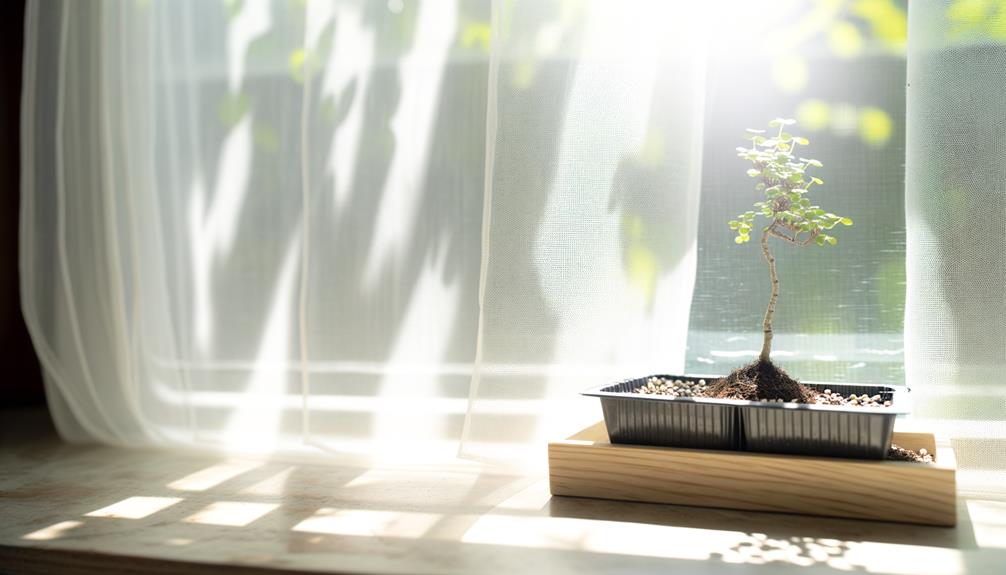
To maximize the benefits of artificial lighting, it is vital to take into account the duration, intensity, and distance of light exposure tailored to the specific bonsai species' photobiological requirements. Implementing a well-structured lighting regimen can greatly enhance seed germination rates and early growth stages.
Here are key considerations:
- Light Duration: Guarantee 12-16 hours of light per day, mimicking natural photoperiods.
- Light Intensity: Utilize grow lights providing 2000-3000 lumens to meet the luminous flux needs of young seedlings.
- Distance: Position lights 2-4 inches above the seed trays to optimize photosynthetic photon flux density (PPFD).
- Light Spectrum: Select full-spectrum LED lights to deliver balanced wavelengths, essential for photomorphogenesis and chlorophyll synthesis.
Accurate light management is vital for fostering robust bonsai seedlings.
Troubleshooting Germination Issues
Identifying and addressing common germination issues is vital for guaranteeing the successful establishment of bonsai seedlings.
One frequent issue is improper stratification, which can hinder seed viability. Stratification involves exposing seeds to cold, moist conditions to break dormancy.
Another concern is substrate quality; a well-draining, sterile medium mitigates pathogen proliferation and ensures sufficient oxygenation.
Additionally, inconsistent moisture levels can greatly impact germination rates. Seeds require consistent moisture, but overwatering can lead to fungal infections like damping-off.
Finally, improper temperature regulation can disrupt germination; maintaining an ideal temperature range, specific to the bonsai species, is key.
Monitoring these variables closely can significantly improve germination success rates and foster robust bonsai growth.
Expert Advice and Recommendations

For the best bonsai seed germination, experts suggest maintaining a delicate balance of light, moisture, and temperature tailored to the specific species. Each bonsai variety has unique germination requirements, and following these can greatly enhance success rates. Key guidelines include:
- Light Exposure: Some species, like pine and maple, benefit from indirect sunlight during germination, while others may need darkness.
- Moisture Levels: Consistent moisture is essential; however, avoid waterlogging, which can result in fungal issues.
- Temperature Control: Most bonsai seeds germinate optimally at temperatures between 20°C to 25°C. Stratification may be necessary for certain species.
- Soil Medium: Use a well-draining, sterile substrate to prevent pathogen growth and support healthy seedling development.
Following these expert recommendations increases the chances of successful bonsai seed germination.
Conclusion
In the intricate dance of nature, light plays a dual role in bonsai seed germination. While certain species require light to break dormancy, others flourish in darkness until sprouting.
The delicate balance between indoor and outdoor environments, combined with artificial light solutions, highlights the complexity of ideal germination conditions. Therefore, the irony lies in the simplicity of light being both a crucial necessity and a variable factor in the successful germination of bonsai seeds.


